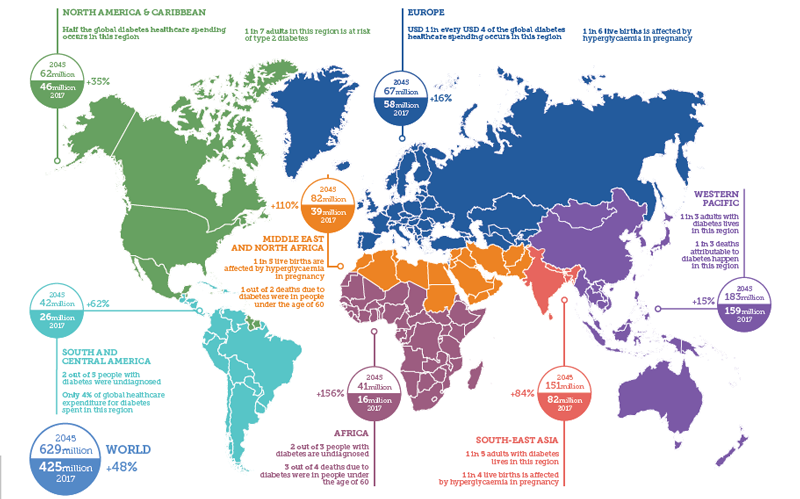Thu 14 November 2019:
Today, 21,463 people have tested their risk of type 2 diabetes. Despite such a high number of people suffering from it, there is little awareness about the condition and its effect on day to day life. To create awareness about diabetes among the common people, World Diabetes Day (WDD) was created in 1991 by IDF and the World Health Organization. The day is marked on November 14 every year. It also marks the birth anniversary of Sir Frederick Banting, who co-discovered insulin along with Charles Best in 1922.

Significance
The main aim of World Diabetes Day is to provide a platform to promote IDF advocacy efforts throughout the year.
Symbol
World Diabetes Day campaign is represented by a blue circle logo on a white background. The symbol was adopted in the year 2007 after the UN passed a resolution on diabetes. Today, the blue circle stands as the global symbol for diabetes awareness.
Theme for 2019
Every year, the World Diabetes Day campaign focuses on a dedicated theme. For the year 2019, the theme is Family and Diabetes. The year is focusing on raising awareness of the impact that diabetes has on the family and support network of those affected.
What is diabetes?
Diabetes is a long-term disease that occurs when the pancreas is no longer able to make insulin — a hormone that regulates blood sugar — or when the body cannot make good use of the insulin it produces, according to the World Health Organization (WHO).
There are three main types of diabetes:
Type 1 diabetes — previously known as insulin-dependent diabetes — is caused by an autoimmune reaction in which the body’s immune system attacks the insulin-producing beta cells of the pancreas, and as a result, the body produces very little or no insulin. This condition requires daily administration of insulin.
The symptoms, which may occur suddenly, include frequent urination, excessive thirst, constant hunger, weight loss, blurred vision, bedwetting and a lack of energy.
Over 1.1 million children and adolescents under the age of 20 live with type 1 diabetes, according to the IDF.
Type 2 diabetes — formerly called non-insulin-dependent diabetes mellitus — is the most common type of diabetes, which accounts for around 90% of the disease worldwide and results from the body’s ineffective use of insulin, causing so-called “insulin resistance,” according to the WHO.
The disease is mostly a result of excess body weight and physical inactivity.
Since the symptoms of type 2 diabetes are mostly less marked, diagnosis of the disease may come several years after its onset, causing health complications.
Gestational diabetes is characterized by high blood glucose levels, or hyperglycemia, during pregnancy.
It may occur at any time during pregnancy — most likely after week 24 — and usually disappears after the pregnancy.
Nevertheless, women with this type of diabetes have a high risk of complications during pregnancy and at delivery, while they and their children are also at increased risk of type 2 diabetes in the future.
An estimated 15.8% or 20.4 million live births have been affected by hyperglycemia in pregnancy in 2019.
Country distribution of diabetes
China, India and the U.S. are the countries with the highest number of adults with diabetes aged 20-79 in 2019 and are forecast to remain so in 2030.
Meanwhile, the IDF reports foresee that the number of adults with diabetes in Pakistan will exceed that in the U.S. and will move to third place by 2045.
In Turkey, the IDF estimates around 6.6 million adults (aged 20-79 years) living with the disease in 2019.
The report also forecasts that Turkey will have 10.4 million people of the same age group with diabetes in 2045.
Think your friends would be interested? Share this story!





